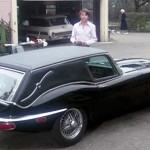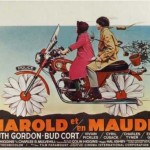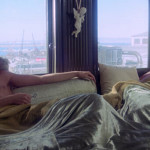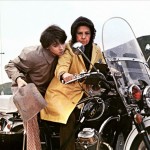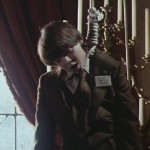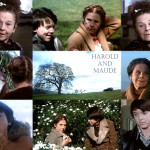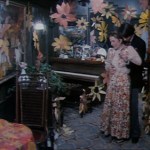Harold and Maude might be painted by some as a satirical romcom for cougars, but it is in fact an inky black comedy that challenged many of the norms and taboos of 1971 American culture, in the way, for example, that Catch 22 used satire to challenge the views of warfare and authority. To say it is about death misses the point – Colin Higgins‘s cunning script uses death as a metaphor for how to live life, exemplified in this quote:
“A lot of people enjoy being dead. But they are not dead, really. They’re just backing away from life. Reach out. Take a chance. Get hurt even. But play as well as you can. Go team, go! Give me an “L”. Give me an “I”. Give me a “V”. Give me an “E”. L-I-V-E. LIVE! Otherwise, you got nothing to talk about in the locker room.”
Lucky for Higgins, he had the prodigious talents of Hal Ashby to bring to life this vision, and Ashby it was that brought from a fine cast performances that stick long in the memory. I’ll come to the leads shortly, but I must mention a true gem of a cameo from British actor Eric Christmas as the priest brought into advise young Harold (see here.) It lasts less than a minute but it had me in stitches – as brilliant a piece of comic performing – and timing – as you will find anywhere. Reading the words isn’t enough – you simply HAVE to watch the character grappling with his conflicting inner-emotions:
“I would be remiss in my duty, if I did not tell you, that the idea of… intercourse – your firm, young… body… comingling with… withered flesh… sagging breasts… flabby b-b-buttocks… makes me want… to vomit.”
The main protagonist of the movie, Harold Chasen (Bud Cort) is a young man from an obscenely wealthy family with a snobbish and aspirational harridan of a mother (beautifully played by another British actor, Vivian Pickles), whose sole aim in life is for her son to become a shining light in society. Harold’s rebellion comes in the form of gruesomely faking his own death (see the list at the bottom) while attending funerals for fun, in the course of which he finds one the one character whose wayward eccentricity makes him glad to be alive.
The fact that she is a 79-year old woman, played with gleeful abandon by the same Ruth Gordon that won best supporting actress Oscar for her performance as a satanist New Yorker in Rosemary’s Baby does not faze Harold in the slightest – though his mother considers it social suicide. She has long since grown tired of the ever more elaborate suicide performances, while sending Harold to see a psychiatrist (George Wood) and his uncle, General Victor Ball (Charles Tyner), both of whom are mad as the proverbial hatters in their own right.
Therein lies the central conceit of the script – and why the comparison with Catch 22 works so well: that those who consider Harold deranged are madder than a box of frogs – and make him seem normal by comparison. By the same token, you can imagine the disapproval ratings for Maude being through the roof, yet she is the only person on his wavelength.
Naturally, Harold does have a deadpan sense of humour and a straight face worthy of the great Leslie Nielsen – which his family most certainly does not “get.” This is displayed to splendid effect by pulling splendid pranks when his mother arranges for him to meet would-be brides via a dating agency. Only the third is not fooled by his suicide display, but in the process offs herself while playing Juliet – an unforeseen consequence.
Gordon’s Maude, by comparison, is not constrained by conventional morality. Her eccentricity and friendship ultimately lead to love, romance, an intention to marry, but then coping with her demise – since in her view 80 is the optimum time to die:
Maude: “Did you know him?”
Harold: “No.”
Maude: “Me neither. I heard he’s 80 years old! I’ll be 80 next week. Good time to move on, don’t you think?”
Harold: “I don’t know.”
Maude: “I mean, 75 is too early, but at 85 you’re just marking time. May as well go look over the horizon.”
Many of the audience would find confronting this reality distinctly uncomfortable viewing, yet in the face of an ageing population it’s never been more apposite – especially when we debate the notion of assisted suicide and the thought that people want to die with dignity and grace – or in this case, disgracefully. Maude takes to heart the message of Dylan Thomas to not go gentle into that good night. She lives live to the full, does just what she fancies doing, including stealing cars and driving them in a manner that would suggest suicide is not long in the making.
Maude also tells the truth, leading to a bizarrely surrealistic encounter and chase with a motorcycle cop (Tom Skerritt, billed as “M Borman.”) Perhaps Maude lives as other people wish they could live, but never had the guts. What if we all stopped being sensible, would anarchy reign? Maybe a bit of that would be no bad thing, says the movie.
There is a serious side though. As one reviewer puts it:
“Simpleminded, but it’s fairly inoffensive, at least until Ashby lingers over the concentration-camp serial number tattooed on Gordon’s arm. Some things are beyond the reach of whimsy.”
On the contrary, I think this puts Maude’s behaviour in unspoken context, the reality from which she has escaped in her American life. For many American Jews in 1971 this would be a reality they knew only too well and from which they too escaped. The point about black comedy and satire is that it is not merely fantasy but grounded deep in the reality of that generation. In short, if it didn’t touch a raw nerve or two there would be little point in H&M.
Another view:
“The fact that [it] isn’t very funny and, like its 80-year-old heroic, long outlives its necessary life, is less important than the fact that the characters frequently react gently or like credible human beings to the script’s impossible notions.”
I grant you that the humour is not to every taste, and like every movie it has its flaws, but at a compact 91 minutes it certainly doesn’t outstay its welcome. I would however say that it is the very humanity of the characters that outlive the outlandish behaviours, since there is more to this movie than meets the eye.
For example, forget the scenario and witness Harold’s tears, his first true exhibition of emotion in the film, when he realises Maude is dying, happily, in a way that to this viewer is eminently more credible than Ryan O’Neal‘s reaction to Ali McGraw dying in Love Story (made in 1970, so you can regard H&M as a satirical send-up of that hit movie.) In spite of the looming image of death, there is a tender-hearted poignancy to the movie.
In the final scene, Harold gives Maude the send-off she would have adored, and walks away playing the banjo she gave him singing a Cat Stevens song. Oh, didn’t I mention that? The movie is replete with bittersweet songs by Cat (aka Yusuf Islam), who was then at the height of his powers. Maybe Ashby bought a job lot, but they somehow reflect in a mirror image the darker tones of the mise-en-scène, and add a wistfully thought-provoking twist.
If you see this movie, you should see it at several levels, one being at face value – but most critics seem to have missed entirely the layered subtlety. Maybe that was me the first time I saw Harold & Maude, but now I get it – and the rich tapestry tells me more about the nature of love and life than a hundred Love Stories!
PS. Harold’s “suicides” in the movie:
Throughout the movie, Harold “dies” seven to eight times. He tells his psychologist at one early juncture that he has made similar attempts in all fifteen times now, which he calls a rough estimate.
- Hanging himself in opening scene: Harold hangs himself while his mother is on the phone. She barely seems to notice this display (at one point she tells him, “I suppose you think that’s very funny, Harold.”) and continues her conversation.
- Letting his mother find him in her bathtub, throat and wrists slit and the mirrors drenched in blood: After this act, Harold sees a psychiatrist.
- Floating dead in pool: Harold floats face down, fully clothed, for an impossibly long time as his mother swims laps past him. Camera shots from below establish that he has no breathing apparatus.
- Shooting himself in the forehead: As his mother reads the questionnaire for the dating service (and answers it according to her preferences, not his), Harold surreptitiously loads a revolver with live rounds, then wheels around and points it at his mother. When after several moments she still does not notice, he turns around and shoots himself. As the blast sends him toppling backward with a hole in his forehead, his mother snaps, “Harold! Please!” and calmly continues with the questionnaire.
- Self-immolation: For the first blind date, Harold sets himself on fire on the diving board in view of the horrified girl, then calmly walks in behind her, with his body still apparently burning outside the window.
- Hand chopping: The second blind date ends abruptly, with Harold chopping off an obviously fake hand. This is the incident that makes his mother decide to send him to the military.
- Seppuku: For the final date, Harold disembowels himself with a sword. Instead of running off like the other dates, Sunshine Doré, a would-be actress, assumes that the act was staged and eagerly joins in. Reciting lines from Romeo and Juliet, she tests the blade with one hand to see its retraction and plunges the fake blade into her chest and acts out a death scene. At that instant, Harold’s mother enters and seeing what she presumes is a dead girl, declares indignantly, “Harold! That was your last date!”
- Car wreck: Grief-stricken over Maude’s death, Harold drives his Jaguar/hearse recklessly up a winding dirt road, sending it flying off a cliff to the rocks below. When the camera tilts from the wreckage up the cliff face, we find Harold standing at the top. He calmly begins to play the banjo Maude gave him and slowly dances away.


